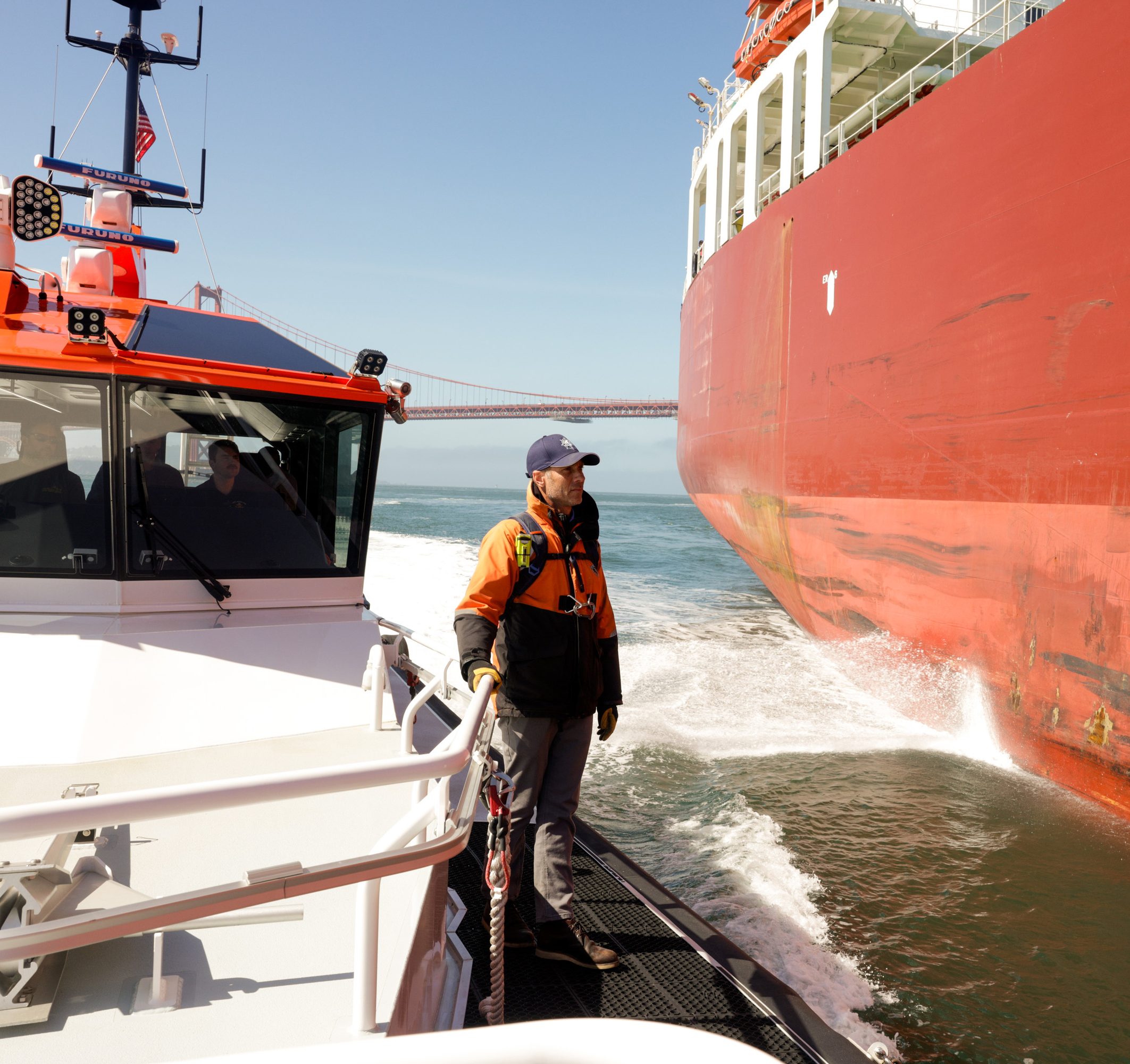Near the Golden Gate Bridge on a crisp April morning, a boat slowly pushes through the swells and noses up to the Champion Timur, a 600-foot crude oil tanker sailing under the Norwegian flag.
A San Francisco Bar Pilot, Capt. David Corbett, outfitted in a safety jacket equipped with a beacon and carrying a tablet with real-time current and weather charts, will take the ship to Pittsburgh where another pilot will take over from him and guide it upriver to port, in Stockton.
Corbett, a longtime pilot who was formerly a captain for Norwegian Cruise Lines for 13 years, knows the charts by heart. “The depths, the locations, the pitch heights—everything,” he said. “We'll transit quite a few bridges and channels and whatnot.”
Corbett walks to the run boat’s bow and casually leaps across the watery gap to grasp a Jacob’s ladder clinging to the tanker’s side. As he’s done countless times before, he climbs to the gangway and walks the deck to the bridge, where he will assist the ship's master and crew in navigating through the bay.
On a sunny morning with relatively calm waters, the transfer from boat to ship is relatively easy. But it’s still a critical and dangerous part of a pilot’s job, requiring timing and judgment—and a leap of faith. Pilots must be able to make the jump 24/7, in smooth seas, gales and everything in between. Safely navigating waterways is critical and dangerous—one of the invisible acts that keep the region’s economy humming.
By law, pilots must be aboard ships 750 gross tons and over that travel the San Francisco and Monterey bays and tributaries to Stockton and Sacramento. They use local knowledge to guide nearly 8,000 ships a year from faraway lands through narrow channels and ever-changing currents, negotiating ship traffic and dodging pylons, bridges and cable crossings—at any time of day or night, during all manner of weather.
Pilots are particularly crucial for navigating the San Francisco Bar—for which they’re named. It’s a horseshoe-shaped area of shallow water created by sediment deposited by outflow from the Sierras. It’s regularly dredged to keep its channels open for shipping lines. Yet, once every so often, the bar presents so much danger during heavy weather that the authorities close it to vessel traffic altogether. When this happens, big ships must sit outside the bay and wait until the coast is clear to move into the channel and on to their final destination.
With their headquarters on an Embarcadero pier, the pilots operate like a public utility. Similar to firefighters, they’re always on call, keeping an offshore station boat about halfway between the Golden Gate and Farallon Islands year-round, where pilots can transfer on and off ships, rest and prepare a course for their next voyage.
Recently the pilots helped out in a rescue that had nothing to do with their usual duties. A boat capsized off San Francisco on April 14, depositing four people into the ocean. The pilot’s station boat went to the scene and pulled two out of the water. The other two were rescued by San Francisco firefighters. On Tuesday, they received a commendation from the Board of Supervisors for their actions.
Occasional rescues aside, what the pilots are here for is safety in commerce—keeping the Oakland Seaport, the ninth-busiest in the nation, productive by steering in and out of port gargantuan cargo ships laden with shipping containers that are longer than Salesforce Tower is tall.
Although they are paid by the ship owners, pilots work for the people of California. The institution dates back to one of the first meetings of U.S. Congress in 1789 when lawmakers established guidelines for states to manage pilotage. One of the first meetings of the California legislature in 1850 established the state-sanctioned compulsory pilotage. The pilots are something of a government-sanctioned collective; there are 60 such organizations across the country.
"Pilots are highly trained; they go through years and years of training before they are licensed,” said Allen Garfinkle, head of a state commission overseeing bar pilots. “The training program is a minimum of one year and a maximum of three. Every five years, they go through a simulator course for bridge resource management. Their training continues throughout their careers."
When the Dali crashed into Baltimore’s Francis Scott Key Bridge last month, toppling the bridge and killing six people, the importance of maritime safety immediately became top of mind for the entire country.
In the Bay Area, the incident immediately brought forth memories of the Cosco Busan, a container ship that struck one of the San Francisco-Oakland Bay Bridge’s fenders, causing a bunker oil spill in 2007. An investigation found the pilot was impaired by medication.
Regulations have come a long way since the incident. “Since the Cosco Busan, we've initiated a fatigue regime—which wasn't related to anything that happened with the Cosco Busan—but certainly, there were medical issues in the Cosco Busan,” Garfinkle said. “Now our medical regime is probably the most strict in the country, with a two-doctor review on every medical assessment.”
New regulations implemented on April 1 after years of review limit the opportunity for fatigue to be a risk. “It's our job to do what's safe, not what's necessarily commercially efficient,” said Capt. Anne McIntyre, the bar pilot association’s business director.
For a San Franciscan watching ships from Crissy Field, the massive hulls may be indistinguishable from each other. But for Corbett, no two ships or passages are ever the same. There will be a different ship, a foreign crew and a new course to navigate. “Every job is so unique in the bay,” he added. “We sort of get a different rush, I think, every time we get on a ship and a different feeling of a new challenge.”
